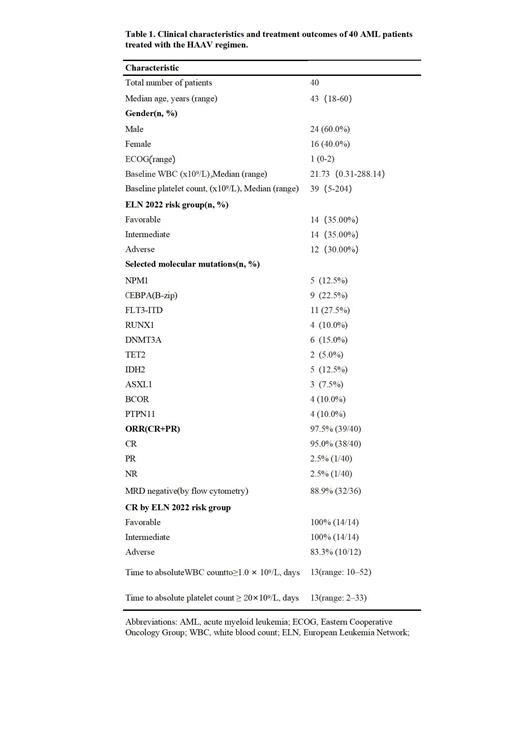Background:
The remission rate of acute myeloid leukemia (AML) patients using traditional induction chemotherapy is approximately 60-70%. Venetoclax (Ven), a b-cell lymphoma 2 (BCL-2) inhibitor, in combination with chemotherapy or hypomethylating agents, has shown a significant increase in remission rates and improvement in patient survival for elderly or unfit for intensive chemotherapy newly diagnosed AML patients. The HAA regimen (consisting of Homoharringtonine, Cytarabine and Aclacinomycin), a specific traditional induction therapy for acute myeloid leukemia in China. The HAA regimen achieved complete remission rates about 70% as an induction regimen for newly diagnosed AML. Whether the combination of Ven with HAA regimen as an induction treatment can further enhance the complete remission rate in newly diagnosed adult AML patients requires investigation through well-designed clinical trials.
Objective:
To evaluate the efficacy and safety of HAA combined with Ven as induction regimen (HAAV) in young adult patients with newly diagnosed AML.
Design, setting and participants:
Single-arm, prospective clinical trial conducted at 8 hospitals in China. Eligible patients (16-60 years old) with newly diagnosed AML (exclude acute promyelocytic leukemia) were enrolled. The trial was registered on ClinicalTrials.gov (NCT05893472) and continues to accrue patients.
Induction regimen:
The induction regimen consisted of Homoharringtonine (2.5mg/㎡/d,d3-7 ), cytarabine (100mg/㎡/d by continuous intravenous infusion daily on d3-7) and Aclacinomycin (20mg/d, d3-7) combined with venetoclax (100mg d1, 200mg d2, 400mg d3-8).
Main outcomes and measures:
The primary endpoint was the overall response rate (ORR) after once cycle of HAAV regimen, which included complete remission (CR), complete remission with incomplete count recovery (CRi), morphologic leukemia-free state (MLFS) and partial remission (PR). Secondary endpoints included minimal residual disease (MRD), overall survival (OS), event-free survival (EFS) and adverse events.
Results:
Untill June 30, 2023, 40 patients were enrolled. The median age is 43 years (range, 18-60), with 60% (24/40) was male. According to the European Leukemia Network prognostic group (2022), 14 (35.0%), 14 (35.0%), and 12 (30.0%) patients were considered to belong to the favorable, intermediate, and adverse groups, respectively. Further details of the patients' characteristics are provided in Table 1.
The ORR (CR+PR) was 97.5% (39/40 patients) after one cycle of the induction regimen with the CR rate was 95.0% (38/40). According to the ELN prognostic group (2022), the CR was 100% in favorable-risk patients (14/14), 100% in intermediate-risk patients (14/14), and 83.3% in adverse-risk patients (10/12). For patients who achieved CR, MRD negative rate was 88.9% (32/36) by flow cytometry. During the induction treatment, all patients experienced ≥Grade 3 hematological toxicity, the remaining common adverse reactions were infections and fever. None of patients died during the induction therapy. In patients who achieved response, the median time to recovery of the white blood count (WBC) to ≥1.0 × 10 9/L and the platelet count to ≥20 × 10 9/L after induction therapy was 13 (range: 10-52) and 13 days (range: 2-33), respectively. ( Table 1)
Conclusions:
Ven combined with HAA (HAAV) is a highly effective and safe induction therapy for young adult patients with de novo AML. To the best of our knowledge, this is the first report about Ven combined with HAA.
Disclosures
No relevant conflicts of interest to declare.


This feature is available to Subscribers Only
Sign In or Create an Account Close Modal